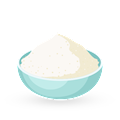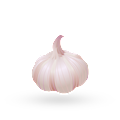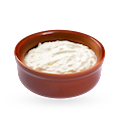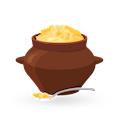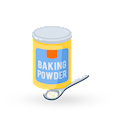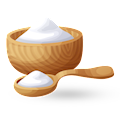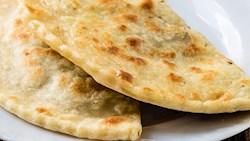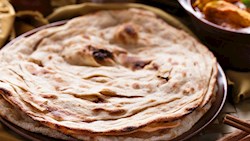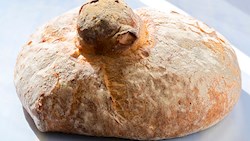MAIN INGREDIENTS
Butter garlic naan is a traditional flatbread and one of the most popular versions of naan. It’s made with flour, baking powder, salt, sugar, and dahi. Once the dough has been baked in a hot tandoor oven, the golden naan is taken out and brushed with butter or ghee, then topped with minced garlic.
It’s recommended to serve butter garlic naan with a variety of Indian dishes such as curries, butter chicken, dal makhani, malai kofta, or shahi paneer.
Coming from the North Indian city of Amritsari, Amritsari kulcha is a flatbread stuffed with potatoes, onions, cottage cheese, and spices. The flatbread is commonly garnished with coriander seeds, cilantro, and red chili powder. Thin, crispy, and smeared with ghee butter, it is a staple food in Amritsar, with almost every shop in the city sizzling with the sound of kulchas baked in large tandoor ovens.
Not much is known about the history of this flavorful dish, and even the locals say that kulcha is just something they have always eaten, a variation on numerous flatbreads that the country is known for.
MOST ICONIC Amritsari kulcha
View moreMAIN INGREDIENTS
Çarşamba pidesi is a Turkish savory pie from Çarşamba district in Samsun, Turkey. Unlike the crispy Bafra pidesi, it is known for its soft texture. This pide is shaped into a long, thin loaf, about 75-80 cm (30-32") in length and 4-5 cm wide (2"), and weighs around 200-220 grams (7 oz).
It is made with a dough leavened with sourdough and with a raw filling consisting of minced beef and onions that have been squeezed of its juice, pepper, and salt. After baking in a wood-fired oven, butter is spread on the hot pide to enhance its flavor.
MAIN INGREDIENTS
Roti canai is a traditional pan-fried flatbread made with flour, water, eggs, and fat of Indian origin, but mainly associated with Malaysia, and surrounding countries like Indonesia, Brunei, and Thailand. The dough for roti canai is repeatedly folded, so the final product has a layered texture, a soft interior, and a crispy outer layer.
The most common fat used in roti canai is ghee, the traditional Indian clarified butter. It is believed that the dish originated in India when the Indian laborers who migrated to Malaysia brought the recipe and the tradition of preparing this crispy pastry to the foreign country.
VARIATIONS OF Roti canai
MOST ICONIC Roti canai
View moreMAIN INGREDIENTS
Pan de bono is a traditional bread consisting of cassava starch, cornmeal or corn flour, queso fresco, eggs, and sugar. The bread is shaped into bagels or balls that are slightly larger than golf balls. Pan de bono is similar to other South American cheese breads like pan de queso, difference being added conr flour or cornmeal, and a hint of sweeteness due to the addition of sugar.
It is usually served warm with a cup of hot chocolate on the side. Some claim that the name pan de bono was created after an Italian baker in Cali who used to yell pane del buono (good bread), while others say that it is named after a place called Hacienda El Bono, where it was first made.
MAIN INGREDIENTS
Parotta is a traditional Southern Indian flatbread, usually sold as street food. It is also popular in Malaysia and Sri Lanka. It is made with oil or ghee, water, refined wheat flour known as maida (unlike parathas, which are made with regular wheat), and occasionally eggs.
The resulting dough is pan-fried and served with various vegetable or meat curries. This flatbread may also be incorporated into various dishes such as kothu parotta that combines shredded parotta with meat, eggs, and a spicy saalna sauce.
MAIN INGREDIENTS
Naan is a unique and popular flatbread with a chewy texture that has its roots in India. The first documented traces of naan are found in the 1300 AD notes of Amir Kushrau, an Indo-Persian poet. Its name comes from the Persian word for bread. Naan was originally made in two versions at the Imperial Court in Delhi - naan-e-tunuk (light bread) and naan-e-tanuri (baked on the stone walls of a tandoor oven).
It consists of white flour, yeast, eggs, milk, salt, and sugar, baked in a tandoor oven. Its typical tear-drop shape is achieved by the way the dough droops as it cooks on the tandoor walls. Many Indian villages had a communal tandoor, placed in the middle of the village so that all the locals could bake naan.
VARIATIONS OF Naan
MOST ICONIC Naan
View moreMAIN INGREDIENTS
Even though today this griddled Italian flatbread is typically enjoyed as a sandwich (one of the most popular fillings includes prosciutto, creamy soft cheeses like squacquerone, tomatoes, and a handful of peppery wild arugula), Piada or piadina Romagnola was once merely a staple of the poor, often made with maize flour and called la pjida ad furmantoun in Romagnolan dialect.
In his poem entitled La Piada, which is sort of an ode to the beloved Romagnolan piadina, a 19th century Italian poet Giovanni Pascoli calls it "the bread of poverty, humanity, and freedom", describing it as "smooth as a leaf and as big as the moon." Since then, the humble, rustic piadina has come a long way and even today takes a special place in the regional cuisine, having been awarded the Protected Geographical Indication status. Le piadine, in plural, can take virtually any ingredients as their filling, and they can be easily found freshly prepared at numerous street kiosks called piadinerie, as it is best to eat a piadina only minutes after it comes off the cast-iron griddle while it's still pliable and warm - the perfect frame for the almost-melting soft cheese and delectable, thinly sliced charcuterie.
MOST ICONIC Piadina Romagnola
View moreMAIN INGREDIENTS
Literally translated to cheese bread, pão de queijo has its origins in the culinary inventions of African slaves, when they started to use the residue of the cassava plant. A fine white powder, or starch, was rolled into balls and baked.
At the time, no cheese was added, so it was just baked starch, but at the end of the 19th century, when slavery ended, other foods started to become available to the Afro-Brazilians for the first time. In the state of Minas Gerais, the dairy center of Brazil, cheese and milk started to be added to the starchy balls, and pão de queijo was created.
MOST ICONIC Pão de queijo
View moreMAIN INGREDIENTS
Hailing from Madeira, this rustic, leavened bread is prepared with wheat flour, mashed sweet potatoes, water, and salt. Traditionally baked on large basalt stone slabs, bolo do caco is typically flat and round, though it can vary in size. It is the most common bread variety on Madeira that is usually served as a warm appetizer with garlic butter spread, but it can also be enjoyed as a sandwich or an accompaniment to various traditional Portuguese dishes.
TasteAtlas food rankings are based on the ratings of the TasteAtlas audience, with a series of mechanisms that recognize real users and that ignore bot, nationalist or local patriotic ratings, and give additional value to the ratings of users that the system recognizes as knowledgeable. For the “Top 100 Breads in the World” list until February 13, 2025, 26,059 ratings were recorded, of which 17,254 were recognized by the system as legitimate. TasteAtlas Rankings should not be seen as the final global conclusion about food. Their purpose is to promote excellent local foods, instill pride in traditional dishes, and arouse curiosity about dishes you haven’t tried.



